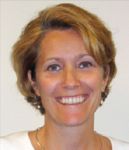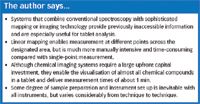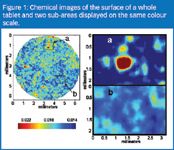Choosing a spectroscopic system for tablet analysis
Pharmaceutical Technology Europe
Vibrational spectroscopy, which encompasses near-infrared, mid-infrared and Raman spectroscopy, is an important analytical tool in the pharma industry.
What do mapping and imaging techniques add to traditional spectroscopic analysis for pharmaceutical applications?
With bulk or traditional single point spectroscopy, one spectrum is collected for each sample using a single element detector with relatively short measurement times. For tablets, this provides one averaged measure of composition for either the whole tablet or a selected portion. Mapping approaches and chemical imaging, on the other hand, record multiple spectra for each sample, providing insight into the distribution of components — most usefully the API and key excipients — across the tablet's surface.

Janie Dubois
Knowledge of the spatial location of different chemical components is valuable for a wide variety of applications, but is particularly useful for the analysis of tablets because it enables manufacturers to understand the links between raw materials, process parameters and a drug's critical quality attributes — the parameters that dictate clinical performance. By identifying the physical distribution of chemical components within the tablet, mapping and imaging techniques allow an appreciation of the relationship between structure and functionality. This helps with the more precise and sensitive definition of critical quality attributes and with the development of understanding of how these can be effectively controlled during manufacture. In this way, these systems closely support the knowledge-led approach enshrined in Quality by Design because they provide the insight necessary to gain a more complete model of product behaviour.
Which applications require the extra spatial detail provided by imaging technology?
Assessing the information required for a particular application is crucial when selecting a spectroscopic system and the need (or not) for spatial detail is key. While case by case consideration is advised, the following examples review some common objectives and information goals.
Quality assurance and quality control
Quality assurance or control often requires only the average chemical composition of a tablet, together with perhaps, averaged measures of moisture content and coating thickness. All of these can be estimated using bulk measurements. Mapping or imaging is needed where spatial resolution is essential, for example in determining chemical and moisture distribution within a sample, and/or coating uniformity. This is the case when distribution rather than just average composition critically impacts clinical performance.

Troubleshooting/root cause analysis
For troubleshooting purposes, bulk measurements provide adequate information about chemical content (dosage) variation over time in a manufacturing run or between batches, or to study differences in properties such as averaged coating thickness between tablets. Spatial distribution information, on the other hand, can help to locate problems with coating integrity and thickness variation across a tablet's surface or at the apex of angled tablets, for example, which may lead to dissolution test failures.
For more in-depth investigation, such as root cause analysis of dosage variation and the underlying reasons for a failed batch, or batch-to-batch variability, spatially resolved measurements provide much more information and have become routine in many companies. This application demands careful consideration of every piece of available information and is consequently an area where imaging techniques have proven their value. Near-infrared chemical imaging, in particular, is favoured for troubleshooting because the field of view of a single image can encompass a whole tablet surface, or even multiple tablets, which makes it very fast and appropriate for the analysis of hundreds of tablets per day. This higher throughput is facilitated by automation and is essential to obtain enough information to confidently make decisions about processes.
Counterfeit detection
Poor counterfeits can be detected easily with single-point spectroscopy because they are often made with different ingredients, or even with no API. A closely copied fake, however, may be extremely similar to a genuine medicine, with differences undetectable by bulk analysis. With spatially resolved information, it is possible to see the size of API and excipient domains across the tablet surface and their relative distribution, both of which are artifacts of the manufacturing process. The positioning of ingredients in a tablet is equivalent to a fingerprint of its formulation and process; for counterfeit investigations, this fingerprint not only demonstrates the fact that it is a fake, but provides more sensitive differentiation that can even help with determining the likely source of a counterfeit product.
Process and product understanding
The latest guidance from the FDA and the ICH encourages an approach where quality is built into a product (Quality by Design) rather than tested for post-production. This relies on a thorough understanding of product performance and the manufacturing parameters that control it. Spatially resolved chemical composition, blend heterogeneity, preferential aggregations, moisture migration and hydration state changes are common examples of product parameters requiring mapping or imaging techniques. Bulk measurements, on the other hand, may be used to monitor dose uniformity, total moisture and sometimes hydration state changes, provided these are large enough to be detected when 'diluted' in the spectrum of the whole tablet.
How do the different spectroscopic systems compare in practical terms?
While all spectroscopic techniques require a certain level of operator proficiency, some systems offer greater user-friendliness or higher levels of automation — both of which can extend the number of users able to operate the system and/or enhance productivity.
Macro, programmable or SOP-type options are necessary tools for the deployment of measurements to a larger group of users. Some degree of sample preparation, presentation and instrument set up is inevitable, but this varies considerably from technique to technique and should be carefully considered at the instrument selection stage. Generally, spectroscopic data acquisition is easy and fast, but data manipulation to extract relevant and valuable information is more tedious. As such, this is the portion that benefits most from automation tools.

Table 1: Concentration distribution estimated from the surface of a whole tablet and from two selected areas, a and b.
Once a mathematical model is in place, averaged compositional analysis by conventional spectroscopy is a simple, cost-effective method. Data acquisition is rapid and easy, with any operator able to generate results; productivity is in the order of thousands of samples per day. Usually an entire tablet is analysed, but if the edges and centre are compositionally identical, then a proportion of the tablet may be sufficiently representative. Table 1 gives a concentration distribution for a tablet based on (a) whole tablet image and (b) two smaller portions of the same tablet. Figure 1 shows the chemical images of the three areas. Together, these underline the importance of selecting a sampling method appropriate to the measurement objective when employing a bulk or averaged measurement technique.

Figure 1: Chemical images of the surface of a whole tablet and two sub-areas displayed on the same colour scale.
Compared with single point measurement, linear mapping is much more manually intensive and time-consuming. With mapping systems, a computer-controlled stage moves the sample relative to the detector, allowing measurement at different points across the designated area. Individual points at which spectra are collected can be selected to cover either the entire tablet area or a representative portion; pixels in a mapped image may arise from areas bordering each other or not. Subsequent analysis of the spectra reveals the identity and distribution of the chemical species across the surface of the sample. Mapping systems demand a high level of flatness that often requires sample embedding and/or sectioning, and data acquisition rates are low; high resolution mapping productivity is in the order of up to just tens of samples per day.
As with mapping, chemical imaging enables the accurate visualisation of almost all chemical compounds in the tablet, determining both the amount present and its location. However, chemical imaging collects thousands of spectra simultaneously from an entire field-of-view, without moving the sample, reducing measurement times to about 1 min. Focusing on a few key wavelengths cuts these further to just seconds, which means hundreds of samples can be measured in a single day. In general, camera-based imaging systems deal well with raw samples, such as whole tablets, granules and transdermal patches, or even whole blister packs, and analysis can be conducted through the packaging.
The camera field-of-view can encompass either the sample surface or 'zoom in' to an area of interest and the pixels of the camera always probe a contiguous area. Since an automated sample changer is invaluable for high throughput projects, selecting an instrument that can be equipped with one and that supports automated data acquisition will significantly streamline analysis.
How can I evaluate the cost-benefit ratio of different systems?
Tablet analysis is conducted for a variety of reasons and the chemical information sought depends on the overall objective; therefore, the cost–benefit ratio is different in every case.
The basic equipment cost associated with spectroscopic technology increases from conventional to mapping systems, with chemical imaging systems requiring the largest upfront capital investment. However, this analysis ignores ongoing cost. On the basis of cost per spectrum, or cost of analysis per tablet, single-point spectrometers remain the cheapest solution, but imaging systems are the next least expensive, with mapping becoming the most costly option because of low productivity and the maintenance requirements for moving parts systems. Finally, the cooling mechanism is also a consideration. Cooling systems that use liquid nitrogen may require filling during a working day and there is also the need for maintenance of the dewar itself and all seals. The stability of the cooling system and its effects on spectral noise should be carefully considered with relation to the throughput required of the instrument and the environment in which it will operate.
Deciding how much money to spend on instrumentation also depends on the financial savings it will deliver. A failed batch that requires reprocessing is a costly fault. Being able to pinpoint the cause and avoid a recurrence requires complete information and the flexibility to access and scrutinise data for hundreds or thousands of tablets. Here, the potential financial savings may well outweigh the initial investment in an instrument capable of solving this problem.
In summary, the decision as to which spectroscopic technique is best suited for a given tablet application rests on a number of important factors. Beyond selecting the most appropriate analytical approach based on application range and the type of information required, choosing the right spectroscopic tool demands a clear understanding and consideration of key issues such as analysis speed, number and expertise of users, potential time and cost gains.
Single point conventional spectroscopy is a well-established, inexpensive method that offers fast averaged composition data for applications where this information is sufficient. Chemical imaging, on the other hand, is the most cost-effective approach over the long term where there is an ongoing need for spatially resolved chemical analysis to support knowledge-led development, effective troubleshooting, root cause analysis and the most sensitive quality control/counterfeit detection.
Janie Dubois Product Manager, Analytical Imaging, Malvern Instruments (USA)

Pharmaceutical Tariffs Are Imminent: How Industry is Bracing for Impact
April 16th 2025On April 14, 2025, the Trump Administration launched a national security-driven investigation into pharmaceuticals, a move that will likely result in tariffs being placed on pharmaceutical drugs, ingredients, and other components that are imported from outside of the United States.
Drug Solutions Podcast: A Closer Look at mRNA in Oncology and Vaccines
April 30th 2024In this episode fo the Drug Solutions Podcast, etherna’s vice-president of Technology and Innovation, Stefaan De Koker, discusses the merits and challenges of using mRNA as the foundation for therapeutics in oncology as well as for vaccines.